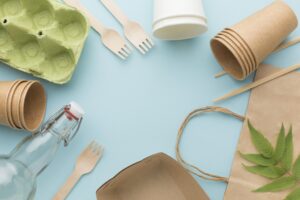
Embracing sustainability: PLASTIC FREE PACKAGING in the food processing industry
In the recent years, the issue of plastic pollution has gained attention throughout the world. India has banned plastic below 75 micron to be used in shopping bags and has enforced min 50 micron in industries to reduce low quality plastic.
The food processing industry is a crucial player here because it extensively uses plastic for its primary or secondary packaging.
Although plastic is the most convenient and cost-effective option, it poses serious environmental threats. Thus, there has been a growing momentum within the food processing sector to adopt plastic-free packaging alternatives, aiming to reduce environmental impact while meeting consumer demands for sustainable products.
Why Plastic-Free Packaging Matters: Plastic pollution has reached alarming levels, with millions of tons of plastic waste ending up in oceans, landfills, and ecosystems each year. The detrimental effects of plastic on marine life, wildlife, and human health are well-documented. In response, consumers are increasingly seeking eco-friendly options, driving the demand for plastic-free packaging in the food industry. By transitioning to sustainable alternatives, food processors can align with consumer preferences, enhance brand reputation, and contribute to a healthier planet.
Sample photo of sustainable packaging

Challenges and Opportunities: While the shift towards plastic-free packaging presents numerous benefits, it also comes with challenges. Food processors must navigate factors such as cost, shelf-life, regulatory compliance, and supply chain considerations when selecting alternative materials. Additionally, ensuring that packaging maintains product freshness, safety, and integrity is paramount. Despite these challenges, the industry has a plethora of opportunities to innovate and collaborate with suppliers, researchers, and policymakers to develop effective and sustainable packaging solutions.
Alternative Materials: A variety of alternative materials are available to replace traditional plastic packaging in the food processing industry. These include:
- Biodegradable and compostable plastics: Derived from renewable resources such as cornstarch, these materials break down naturally, reducing environmental impact. However, their effectiveness depends on proper disposal methods and infrastructure for composting.
- Paper and cardboard: Recyclable and biodegradable, paper-based packaging offers a versatile option for a wide range of food products. It can be coated or treated to enhance barrier properties and extend shelf-life.
- Plant-based materials: Materials derived from plants, such as sugarcane, bamboo, or algae, offer sustainable alternatives to conventional plastics. These materials are renewable, biodegradable, and often compostable.
- Glass and metal: While not suitable for all food products, glass and metal packaging are durable, recyclable, and inert, making them ideal for preserving taste and quality.
- Edible packaging: Innovative solutions such as edible films and coatings made from natural ingredients offer a novel approach to packaging, reducing waste and enhancing consumer experience.
Best Practices for Implementation: To successfully transition to plastic-free packaging, food processors should consider the following best practices:
- Conduct a comprehensive assessment of current packaging practices and identify opportunities for improvement.
- Collaborate with suppliers, packaging manufacturers, and industry partners to source sustainable materials and develop innovative packaging solutions.
- Invest in research and development to enhance the performance and functionality of alternative materials.
- Educate consumers about the importance of plastic-free packaging and provide clear instructions for proper disposal or recycling.
- Monitor and evaluate the environmental impact of packaging initiatives and continuously seek opportunities for optimization and improvement.
Case Studies: Several food processing companies have already made significant strides towards plastic-free packaging. For example, Nestlé has committed to making 100% of its packaging recyclable or reusable by 2025 and has introduced paper-based packaging for its KitKat bars. Similarly, Unilever has launched a range of ice cream products packaged in cardboard tubs lined with a plant-based coating, reducing the need for traditional plastic packaging.
Conclusion: The transition to plastic-free packaging in the food processing industry represents a critical step towards a more sustainable future. By embracing innovation, collaboration, and consumer education, food processors can reduce their environmental footprint while meeting the growing demand for eco-friendly products. While challenges remain, the industry has the opportunity to lead by example and inspire positive change across the entire packaging supply chain. Together, we can create a world where packaging enhances, rather than detracts from, the health of our planet.


No Comments